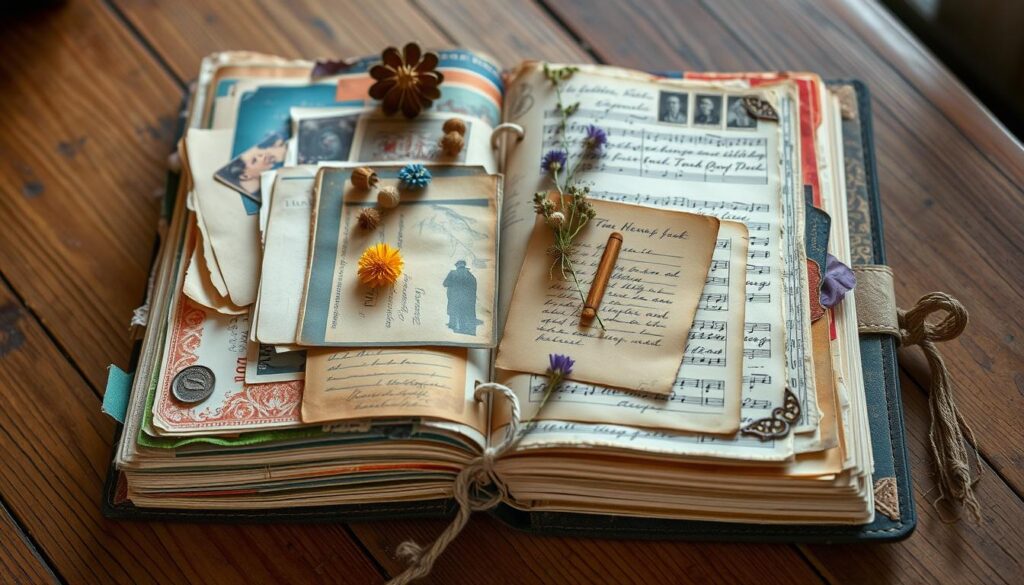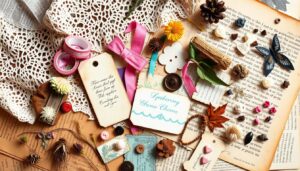Are you curious about junk journaling but don’t know where to begin? Crafting your own junk journal is a fun and rewarding journey. It lets you express your creativity and turn old materials into something special. In this guide, we’ll show you how to make your own unique junk journal.
Key Takeaways
- Junk journals are handmade books made from recycled and repurposed materials.
- They can be customized with vintage-inspired designs, ephemera, pockets, and other unique embellishments.
- Junk journaling is an affordable and therapeutic hobby that allows for personal expression and creative freedom.
- With the right materials and step-by-step guidance, even beginners can craft stunning junk journals.
- Junk journals can serve as both functional journals and works of art, making them versatile and cherished creations.
Understanding Junk Journals and Their Purpose
Junk journaling is a fun DIY craft that lets people show off their creativity. It turns old materials into special keepsakes. This art form started with the idea of giving new life to things we might otherwise throw away.
Origins and Evolution of Junk Journaling
The idea of junk journaling began with the upcycling movement. Artists and crafters wanted to find new uses for old items. They made unique journals that showed off their personal styles and stories.
Benefits of Creating a Junk Journal
Junk journaling does more than just let you be creative. It helps you keep memories and thoughts in one special place. These journals become precious keepsakes that you can look back on and share with others.
It also helps you relax and be more mindful. It’s a hands-on way to slow down and connect with yourself.
Different Types of Junk Journals
- Vintage-themed junk journals
- Travel journals
- Scrapbooks
- Wedding guest books
- Gratitude logs
- Dream journals
- Reflection journals
- Habit trackers
Junk journals can be made for many different reasons. You can use them to keep memories, grow as a person, or just to express yourself.
“Junk journaling is more than just a hobby – it’s a way to connect with the past, express our creativity, and leave a lasting legacy.” – Sarah, Avid Junk Journalist
Essential Materials and Supplies Needed
Creating the perfect junk journal requires the right supplies. From the base to the embellishments, each item is crucial. Let’s look at the key materials and tools for starting your junk journaling journey.
The base of your journal can be a notebook, a repurposed book, or handmade. Add depth with old book pages, vintage papers, music sheets, and specialty wrapping papers.
Use a needle and thread, especially linen thread, for a strong and lasting stitch. For the covers, get creative with cardboard, chipboard, or items like cereal boxes and file folders.
- Scissors or a craft knife for precise cutting
- A cutting mat to protect your surfaces
- Adhesives like PVA glue, glue sticks, double-sided tape, and Mod Podge
- Decorative elements like stamps, washi tape, ribbons, buttons, and ephemera
- Writing tools such as pens, pencils, markers, and rubber stamps
- A ruler for accurate measurements
- Various papers, such as tea or coffee dyed paper, graph paper, scrapbook paper, vintage book pages etc.
While these supplies are the basics, feel free to add personal touches. Junk journaling is about creating something unique that shows your style and interests.
You can also use printable junk journal papers and curated junk journal kits, such as the printables I sell on Etsy,
Here is an example
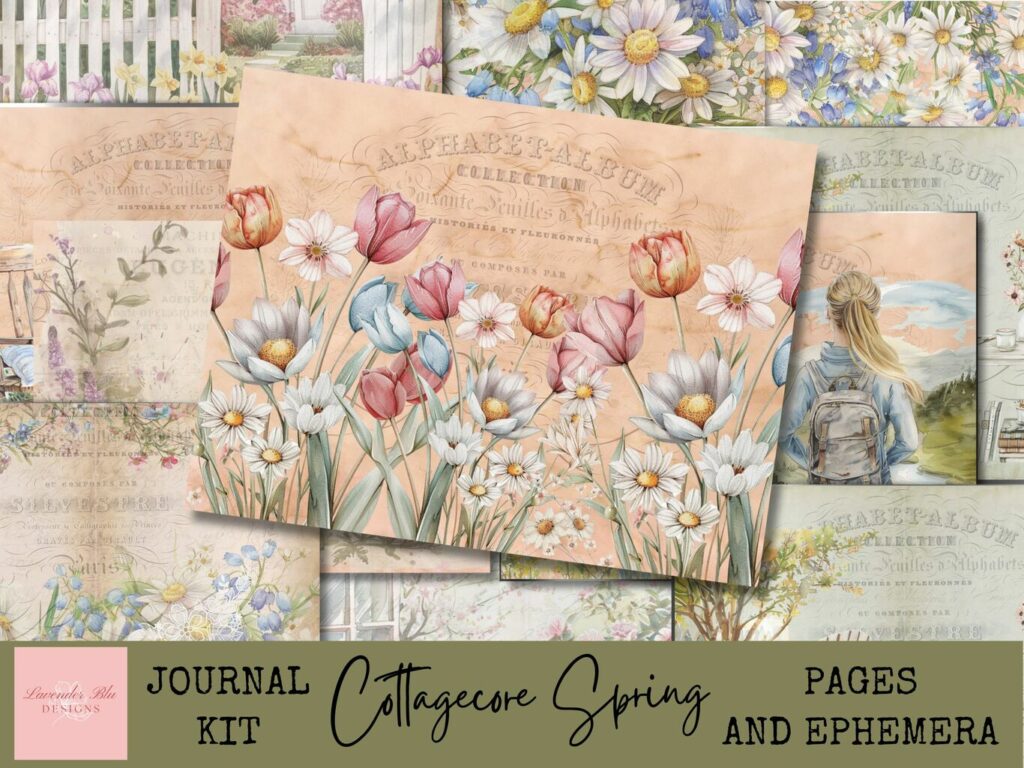
You can combine the printable kits with other papers to make it truly your own.
VISIT MY SHOP
| Product | Recommendation | Reason |
|---|---|---|
| Canon Pixma MegaTank Printer | Highly Recommended | Filled over a year ago, printing hundreds of pages without needing a refill |
| Fiskars Rotary Trimmer | Upgraded Recommended | Replaced frequently due to frustration with blades |
| Neenah Paper Linen | Highly Recommended | Texture and durability superior to regular computer paper |
| Fabri-Tac Glue | Highly Recommended | Strength and acid-free properties make it ideal for junk journaling |
| Tombow MONO Permanent Tape | Highly Recommended | Quality and PAT tested feature make it a top choice |
| Tim Holtz Non-Stick Scissors and Snips | Highly Recommended | Durable and versatile for fussy cutting and trimming |
| Scrapbook Project Holders and Washi Tape Organizers | Highly Recommended | Essential for maintaining a neat workspace and organizing ongoing projects |
With these junk journal supplies, recycled materials, and paper crafting tools, you’re ready to make a unique and personalized junk journal. It will showcase your artistic flair and storytelling spirit.
How to Make a Junk Journal: Step-by-Step Process
Making a junk journal is a fun and personal journey. It lets you show off your creativity. This guide will help you make your own junk journal, whether you’re new or experienced. Let’s start exploring the world of junk journaling!
Planning Your Journal Layout
First, gather your materials and think about what you want your journal for. Do you want it for daily planning, as a memory book, or for art? Pick a theme or style to guide your choices and layout.
Creating the Basic Structure
Begin with the journal’s core. Use materials like cardstock, old book pages, and packaging scraps. Fold and assemble these into signatures, which are the heart of your journal. Try different binding methods, like sewing, binder rings, or the no-sew method.
Adding Signatures and Pages
- Fold your paper into signatures, mixing sizes and textures for interest.
- Add pockets, envelopes, and ephemera for unique pages and fun elements.
- Go for about 40 pages to leave room for more creativity.
Creating a junk journal should be fun and relaxed. Don’t worry about mistakes. The beauty of a junk journal is its uniqueness. So, enjoy and let your style show!
| Binding Method | Advantages | Disadvantages |
|---|---|---|
| Sewn Book Binding | Durable and professional-looking | Requires more time and skill |
| Binder Rings | Allows for easy page additions and rearrangement | May not have the same vintage aesthetic |
| No-Sew Perfect Binding | Quick and easy to execute | May not be as sturdy as other methods |
| Altered Book Method | Repurposes an existing book for a unique journal | Limited to the size and shape of the original book |
“Junk journaling is all about embracing the imperfections and letting your creativity shine. It’s a journey of self-expression and personal exploration.”
By following these steps, you’ll create a junk journal that shows off your unique style. Happy crafting!
Choosing and Preparing Papers for Your Journal
Creating a junk journal starts with picking and preparing papers. Use a mix of vintage paper, tea-dyed sheets, newspaper, and scraps. This variety adds depth and character, making your journal special.
Look for different types of paper for your junk journal paper ideas. Try computer paper, construction paper, vintage-looking cardstock, and more. Mixing sizes, colors, and textures makes each page exciting.
- Try tea-dyed or avocado-dyed papers for a unique look.
- Add sheet music, old envelopes, and ephemera for extra flair.
- Use wrapping paper, tissue paper, and other unexpected items to make your journal stand out.
Junk journaling is all about being creative and spontaneous. Let your paper choices and preparation guide you. This way, you’ll create a journal that’s truly yours.
CHECK OUT MY PRINTABLE JUNK JOURNAL PAGES
Creating a Unique Journal Cover
Making a junk journal cover is a chance to show off your creativity and style. You can pick the right cover material and decorate it with cool elements. The cover is the first thing people see, so make it special.
Cover Material Options
Kraft cardstock is a favorite for junk journal covers. It’s strong and easy to decorate. Cut it to fit your journal perfectly. You can also use old book covers, recycled stuff, or fabric scraps for a unique look.
Decoration Techniques
- Add vintage images, sheet music, or fabric strips for texture and interest.
- Try distress ink for a worn look that fits the junk journal vibe.
- Play with mixed media like molding paste, paint, and ephemera for layers.
Binding Methods
After decorating, think about how to bind your cover. Saddle stitching is a classic choice. Or, you could use ring binding or make a hard cover with chipboard and book cloth.
Have fun and let your creativity flow, no matter what you choose. Embrace the unique and upcycled feel of your cover. It’s all about making it your own.
Adding Pockets, Tags, and Embellishments
Make your junk journal special by adding pockets, tags, and embellishments. These features not only look good but also help you store things and write more. Your journal will become a unique piece of art.
Begin by making pockets for small items like notes or tags. You can fold paper or use envelopes to make these pockets. They stick well to your journal pages. Decorative tags let you write, collage, or add fun touches to your journal.
- Use ephemera packs or make your own tags with cardstock, ribbon, lace, and stamps.
- Try different shapes and sizes to make each tag special and yours.
- Add embellishments like buttons, fabric, and vintage items to give your pages texture and depth.
Junk journaling lets you be creative and express yourself. By making creating journal pockets and decorative tags, you can make your journal a showcase of your style.
“Junk journaling is not just about creating a functional notebook; it’s about unleashing your inner artist and letting your creativity shine through every page.”
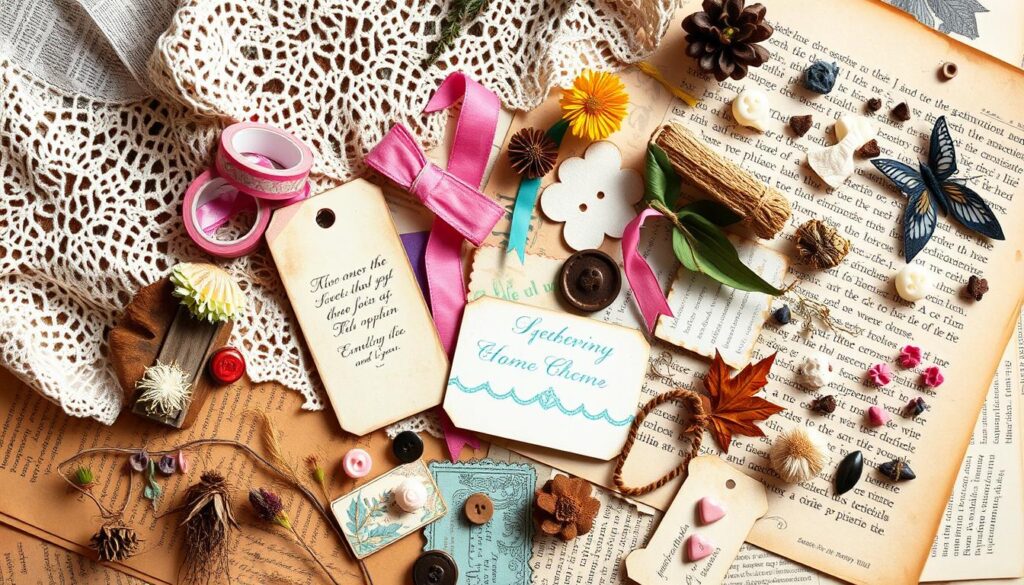
Remember, the most important thing is to have fun. Don’t worry about mistakes. Try new things and watch your journal grow with pockets, tags, and embellishments.
Incorporating Vintage Elements and Ephemera
Vintage ephemera and aging techniques make junk journals truly special. They add a sense of history and character. This section will show you how to use these elements to bring your journal to life.
Sources for Vintage Materials
There are many places to find vintage materials for your junk journal. Look in local antique shops, flea markets, and online on Etsy or eBay. You can find old books, magazines, postcards, stamps, and ticket stubs. Get creative and mix different items for a unique look.
Aging Techniques for Papers
After finding your materials, it’s time to age your papers. Simple techniques can make them look old and worn. Try staining with tea or coffee, or use distress inks for a worn look. Crinkle or tear the edges for extra aging. Experiment to find the right look for your journal.
“Junk journaling allows me to preserve the past and create something truly one-of-a-kind. The process of finding and incorporating vintage elements is both exciting and rewarding.”
Junk journaling is all about embracing the unexpected. Let your materials’ imperfections shine. This way, your journal will reflect your unique style and vision.
Binding Techniques and Methods
Making a junk journal is more than just picking materials. The binding techniques you use can really change how your journal looks and works. From traditional stitching to new ring binding, choosing the right binding is key to making your journal special.
Stitching Techniques
Saddle stitching is a favorite for junk journals. It uses a needle and waxed thread to sew the pages together along the spine. This method gives your journal a unique, vintage look.
Ring Binding
Ring binding is another great way to bind a junk journal. You need a hole punch and metal or plastic rings. These rings go through holes in the pages, making it easy to change or add pages.
When picking a binding method, choose materials that match your journal’s look. Waxed thread, twine, or colorful ribbons can make your stitching stand out. Metal or plastic rings come in many sizes and finishes, so you can find the perfect fit for your journal.
| Binding Technique | Description | Advantages |
|---|---|---|
| Saddle Stitching | Stitching the signatures (folded pages) together along the spine using a needle and waxed thread | Adds a vintage, handmade look; Allows for exposed stitching as a decorative element |
| Ring Binding | Inserting metal or plastic rings through pre-punched holes in the pages | Enables easy page removal and rearrangement; Offers a flexible, modular structure |
The binding method you choose should match your journal’s look and purpose. Whether you prefer the classic charm of saddle stitching or the flexibility of ring binding, the binding process is essential. It makes your junk journal truly unique and personal.
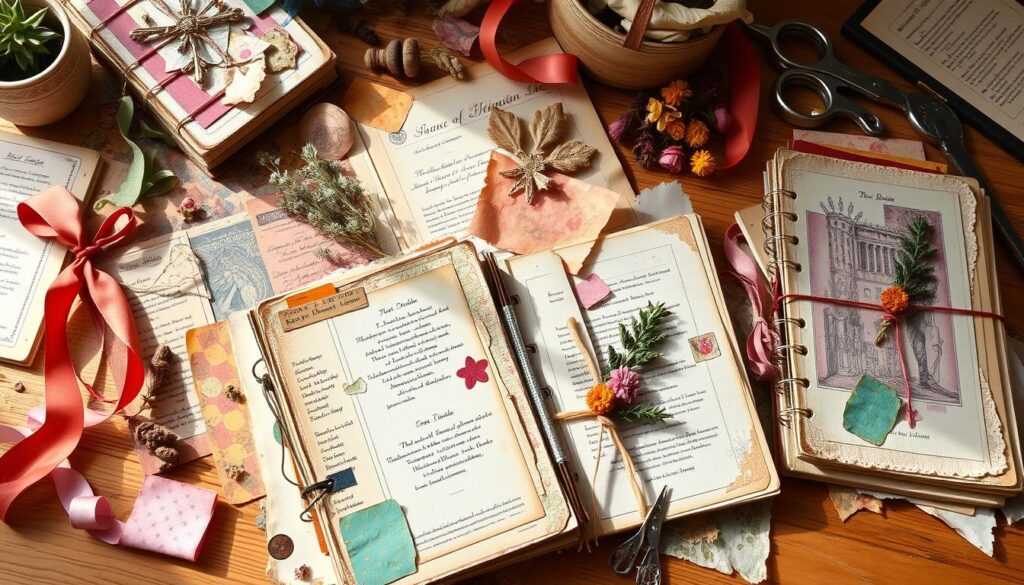
Decorative Elements and Finishing Touches
Make your junk journal stand out with mixed media and creative embellishments. Try painting, stamping, or collaging to add depth. Use washi tape, stickers, or pressed flowers for a personal touch. Metallic markers can add elegance to certain elements.
Mixed Media Techniques
Get creative with mixed media journaling. Use acrylic paints, stamp with archival inks, or make collages with paper scraps. These methods can make your pages more interesting and textured.
Creative Embellishment Ideas
Add a personal touch to your junk journal with embellishments. Washi tape can create borders and pockets. Stickers, both die-cut and printed, add fun touches. Pressed flowers and leaves bring a natural feel to your pages.
I have many ideas, inspiration and tutorials on my youtube channel
FAQ
What is a junk journal?
A junk journal is a handmade book filled with memories and ideas. It’s made from scraps like old magazines and half-used notebooks. You can make it vintage or your own style.
What are the benefits of creating a junk journal?
Junk journaling keeps memories in one spot. It’s relaxing and a great way to bond with others. You can use it for gratitude, dreams, reflection, or tracking habits.
What materials are needed to make a junk journal?
You’ll need a journal base, paper, tape, glue, scissors, and pens. You can also use printed paper, magazines, and markers. Add personal touches like tickets and dried flowers.
How do I start making a junk journal?
First, gather your materials and decide what the journal will be for. Make the cover from cardstock or an old book. Fold papers to make signatures and add pockets for fun. Aim for 40 pages.
How do I choose and prepare papers for my junk journal?
Pick a variety of papers like computer and construction paper. Use different sizes, colors, and textures. Tea-dyed papers give a vintage look. Add sheet music and paper scraps for character.
How do I create a unique journal cover?
Use kraft cardstock for the cover. Decorate it with vintage images and fabric strips. Distress ink adds an aged look. You can bind it with stitching, rings, or a hard cover.
What techniques can I use to add embellishments and textures?
Add pockets and tags for decoration. Use ephemera packs or craft supplies for themed embellishments. Ribbons, lace, and stamps add texture and interest.
How can I incorporate vintage elements into my junk journal?
Find vintage materials in old books and magazines. Tea or coffee stain papers for an aged look. Use distress ink and add vintage items like stamps and photographs.
What binding techniques can I use for my junk journal?
You can use saddle stitching or ring binding. For stitching, use waxed thread and a needle. Ring binding needs rings and a hole punch. Choose exposed stitching for decoration or a cover-wrapped method for a clean look.
How can I add creative embellishments and finishing touches?
Try painting, stamping, or collage for mixed media. Add washi tape, stickers, or pressed flowers. Use metallic markers for accents. Add quotes and sketches to make it personal.
